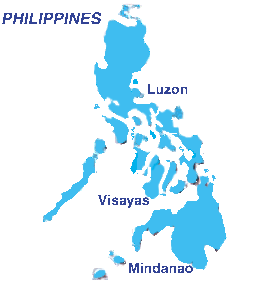Philippines Hotels & Travel Guide
|
Mindanao, the second largest islands of the Philippines, is a land
of towring mosques and malong-clad women, where boldly-striped vintas
ply the waters between houses perched precariuosly on stilts. Here,
ethnic tribes weave glorious tales of brave warriors and haughty princesses
into colorful tapestries and fabrics.

Mindanao is also a nature lover's paradise: Tiny Camiguin isle enchants
with its white sand islands and volcanic chains. Zamboanga has pink
sand beaches for beach-lover and rolling greens for the golf enthusiast.
Davao's caves promise adventure for spelunkers; in this land of fruits
and flowers, parklands are planted with groves of durian, rambutan and
other exotic tropical fruit trees, intersperesed with tropical blooms
and exotic orchids. Cotabato's pineapple plantations and Bukidnon's
citrus farms delight with nature's freshest harvests.
The adventurous travel would probably wish to conquer Mindanao's vast
mountain wilderness or explore the many forests and wildlife reserves.
Mt. Apo in Davao del Sur is the country's highest peak. Climbers are
trekkers will find on its slopes forests exotic flora, steaming geysers,
rainwater lakes, swift flowing rivers and cascading waterfalls; and
at itsbase, Mount Apo Science Foundation, an agricultural institutuin
surrounded by woodlands ideal for bird-watching.
A plethora of water falls awaits the visitor to Lanao del Norte. Its
provicial capital, Iligan, is home to the legendary Maria Cristina Falls,
100 feet higher than the awesome of Niagara. Lanao del Sur, around majestic
Lanao Lake, is the Islam Center of the South. Here are found repositories
of Muslim culture such as the Mindanao State University, the King Faisal
Center for Arabic Studies and the Aga Khan Museum.
The artistry and diversity of ethnic tribes lend a richness to local
color. The Maranao have their okir, a curvilinear carving tradition
that sets off their houses, musical instruments, personal ornaments
and household implements in brilliant colorful motifs. Visitors will
find unique souvenir items among the handicrafts of the T'boli, who
weave theirfamous t'nalak patterns. The Sama tribes hand-weave cool
mats in jewel colors along the walks of their stilt houses inviting
spectators to bargain for their wares. The sea-faring Badjao dive for
coveted South Sea pearls. Arts and crafts demonstration tours, tribal,
festivals, and visits to ethnic villages provide insight into the everyday
lives of the cultural minorities.
Bird Feeders
Kids are naturally attracted to animals and will love the birds that come to eat off of their
homemade bird feeders. The following instructions are for a very simple bird feeder that
can be made again and again. Once you put out food for birds and they start coming on a
regular basis you should continue to feed them as they are rely on the feeders as a food
source. Bird Feeders Motivational & Inspirational Quotes:
Never go on trips with anyone you do not love. Ernest Hemingway
Own only what you can always carry with you: know languages, know countries, know people. Let your memory be your travel bag. Aleksandr Solzhenitsyn
|